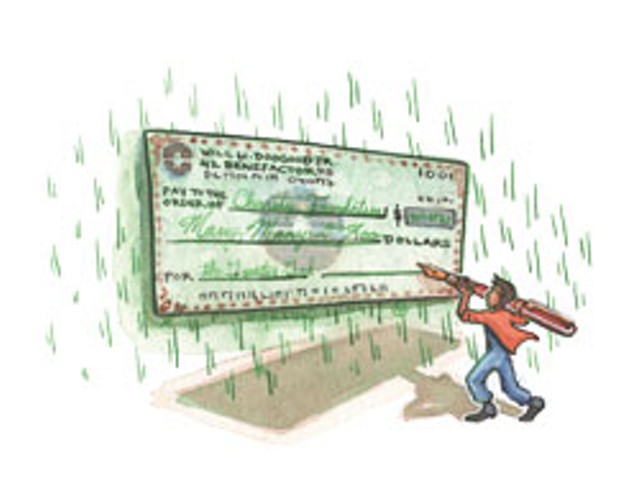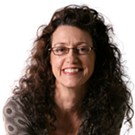Published December 29, 2009 at 6:12 a.m.
Remember that appeal you received back in November, the one you “filed away” with the others now piled high in your in-box? A dizzying number of Vermont nonprofits is now looking for your check amongst the flood of end-of-the-year donations. Traditionally, the last week of December is a big one for charitable giving as people rush to make tax-deductible contributions.
But 2009 has hardly been a “traditional” year. The ongoing recession has squeezed a lot of Vermont’s 501c3s— particularly those that deliver “non-essential” services such as culture, history and education. Burlington City Arts director Doreen Kraft reports donations are down as much 50 percent.
The economic downturn has been a nightmare for nonprofits, but it won’t last forever — at least in theory. More worrisome to Kraft and other fundraisers is a looming challenge that could threaten their organizations’ long-term survival: cultivating the next generation of philanthropists. Who will carry on the outsized charitable giving practiced by Vermont’s funder families — the McClures, Millers, Pecors, Tarrants and Hoehls, to name a few — in an era that may not generate the kind of profits they realized?
“That is the huge and critical question,” says Stuart Comstock-Gay, executive director of the Middlebury-based Vermont Community Foundation, a public charity that assists Vermont-focused philanthropists, organizations and businesses with planned giving and nonprofit endowment management.
It’s a timely one, too. Between 1998 and 2052, roughly $41 trillion in U.S. wealth is expected to pass from aging baby boomers to their children, according to VCF communications director Felipe Rivera. “It’s going to happen much more quickly [here] because our population skews older,” he predicts. “You have something like $9 billion to be transferred in Vermont by 2015.”
From Rivera’s perspective, the “intergenerational transfer of wealth” represents “a tremendous opportunity to develop and build charitable resources for the community… Simply reminding people to think about leaving a small portion of their estate, or their IRA, or their insurance policy, to support the causes they care about, has the potential to generate a lot.”
But that won’t help the people who raise money for the arts, the food shelf, the humane society and the hospital to hone their arguments for a younger audience. What will it take to convert the heirs of a generous generation into the reliable, civic-minded donors their parents were?
“Mature donors,” as Rivera refers to old-fashioned philanthropists, tend to focus their giving on a particular place — usually where they live, notice problems, “and have access to people who are giving them information about who’s doing good work,” he notes.
In Chittenden County, Lois McClure may be the most striking example of this approach to charitable giving. Her family — the Howes — owned the Burlington Free Press
for generations, and her husband, J. Warren “Mac” McClure, made millions when he sold it to Gannett in 1971. “When you have a newspaper, you feel very, very responsible for the community you are reporting on, and you see the needs,” Lois McClure explains. “I grew up with that kind of philosophy.”
That the McClure name is emblazoned on buildings all across Chittenden County is a testament to Mac’s motivational strategy: “My husband felt that you should let people know what you’re doing. Otherwise, they might assume you weren’t doing anything. Or that you disapproved,” says Lois, who has carried on her husband’s philanthropy since he passed away five years ago. She contributes generously to 64 nonprofits, all but five of which are in Vermont.
Kraft recalls stories from local philanthropists Bob Miller and Pat Robins about old Burlington, when a handful of high rollers would pressure each other into pledging money for projects that helped make the city what it is today. “One of them would say, ‘OK, we’ve gotta deal with this issue in our town. I’m going to put in $10,000. Are you in for 10? Are you in for 10?’ That’s how it was done,” she says.
“Survival of a small town was really dependent on the few wealthy individuals in it,” Kraft adds. “They wanted it to be a great experience for themselves and others — and they gave. People don’t feel that automatically now.
“Young people feel connected to causes, that’s for sure,” Kraft continues, “but … they’re not sure of how to be a philanthropist.”
Rivera and his colleagues work with donors who want their children to carry on their charitable work — and, in some cases, to take it to the next level. The VCF advises these young people who are inheriting significant resources. Rivera says that, generally speaking, they take a more global view of giving — “for many reasons, not the least of which is the Internet … They say, ‘Sure I want to do something significant in my hometown. But I also want to make sure that I think about what’s going on in India.’ That’s a very, very different thing from what you see with traditional donors.”
The choices are endless. But budding philanthropists’ willingness to consider them suggests they have a greater appreciation for how problems are interconnected.
“You take that flexibility in being able conceptualize a strategy that encompasses many aspects of community life, and you combine it with an upbringing that has relied largely on access to information and problem solving ,” Rivera says. “It gives me great hope for what might be accomplished.”
Themes seem to motivate the younger generation more than individual institutions do. That bodes well for the < ahref="http://www.unitedwaycc.org/">United Way of Chittenden County, which organizes its annual fundraising by “impact areas” such as basic needs, community engagement, health and well being.
How the United Way delivers data, however, does not yet meet the demands of younger, results-driven donors. “They want to know where their donation went. How it worked. We need to provide that information electronically,” says communications director Bobbe Maynes, noting the organization is raising $4.1 million without online pledging. “That’s a huge missing piece for us.”
Maynes admits the United Way, which makes workplace presentations, hasn’t been successful in getting its message into younger companies. That motivated last year’s formation of its Next Gen Advisory Committee “to find out how we can stay relevant,” she says. “Our donors are aging. We know we need to bring new donors into the mix.”
Heading up that effort is 39-year-old Brett Smith, a co-owner of Burlington’s Fuse Marketing. Not only does his business target the younger demographic; Smith himself serves as an ideal case study for the United Way. He grew up in a philanthropic family — his mother was on various community boards — but didn’t think much about it for himself until his mid-thirties, when he was settled in Burlington.
Smith says he believed from a young age that “challenges in the community are everyone’s responsibility.” After focusing on his career for a decade, “I evaluated where I was in my life and a decided there was piece missing: I wanted to get involved in the community.”
Volunteering led to a desire to contribute financially, which led to an invitation to join the United Way board — the classic philanthropic path. Vermont ranks ninth in the nation for free labor, according to a recent report, “Giving in Vermont,” published by the VCF; a whopping 35.6 percent of Vermonters donate their time to charitable organizations.
“A lot of young people are interested in getting involved, but don’t necessarily know what they want to do, or where they want to go, with that desire,” Smith observes.
And unless they’ve inherited wealth, most won’t be financially secure enough to be reliable donors until their children are out of college.
But nonprofits should start cultivating future donors long before that. Based on his research through the United Way, Smith says young people are more likely to get involved in causes to which they have a personal connection.
Kraft broadens that theory to suggest tomorrow’s philanthropists are seeking an “emotional connection.” The more engaging the story, the more likely donors will respond. She gives Burlington’s Hicks Foundation as an example. After her own diagnosis with cervical cancer, at 29, local resident Allison Hicks started a nonprofit to promote better health care screening for young women.
The Hicks Foundation raised $30,000 in 2008 through a huge clothing exchange — an event perfectly suited to a younger demographic, according to Kraft. “People aren’t just writing a check; they’re donating clothing.” The garments are sold at a discount in a bargain-basement type atmosphere. In the end, she notes, “You are giving a gift but also getting something for it, too.”
Kraft, Smith and Rivera agree that fun social events are key to getting young people interested in giving. “Things like giving circles for younger donors hold huge potential,” Rivera notes. “They are much more inclined to work in groups, whether virtually or sitting down together at the local general store.”
The good intentions are there, Smith confirms. Generally speaking, he says, young people view community building as “something good, something they should be involved in, and something the businesses they work for should be involved in.” The challenge is turning that into action.
Kraft makes a distinction between charity and philanthropy. In her view, charity is “what you do” to meet the basic needs of those less fortunate. Historically, the church had a big hand in that. Families that agreed to be tithed — as Kraft’s did when she was growing up — trusted the church to distribute the resources. “Not to diminish charity,” says Kraft, “but charity is like a finger in the dyke.”
With philanthropy, on the other hand, “you rebuild the wall.” It comes from “an intentional desire to make a change in the world,” she offers, whether it’s responding to an injustice or promoting a positive change. With focused and consistent financial contributions, a philanthropist can shape how society and culture evolve.
But philanthropy also requires education, Kraft suggests, and nothing beats a parental role model. It’s no surprise that Trey Pecor of Lake Champlain Transportation is carrying on his father’s foundation along with his ferry business. “I had a mentor who taught me that where we live is a jewel and we have to take care of the community … he hammered it into me,” Pecor says of his dad, Ray.
Others may need coaxing. “Those of us who are dependent upon philanthropy in our communities know that we have to get to know people really well and educate them,” Kraft says. “It’s not that we weren’t doing that; it’s that now we understand we have to do it. You need to cultivate those relationships and hopefully get people to make the first gift.”
Vermonters give their time generously, but they contribute 25 percent less to nonprofits than the national average, according to the VCF report. The difference between the two numbers, multiplied by Vermont’s donor population, is $88 million. “Even after adjusting for income,” the report states, “Vermont’s average contribution places it at the bottom 10 states in the nation.”
Rivera likes to think about what $88 million could do for Vermont. Given the state’s small scale, he argues, “You can contemplate ending childhood hunger. You can contemplate ending homelessness. In Vermont we have a lot of people who believe you can actually end some of those problems.”
Lois McClure is doing her part. “Imagine what December is like in my mailbox,” she says with a chuckle. “If people could realize how much it does for them. To think that you can give when you’re still alive and see things happen. My husband called it giving with warm hands instead of waiting. He didn’t want to leave a big estate. He thought the worst thing he could do for his kids was to leave them rich.”
Want to learn more?
Vermont Community Foundation President Stuart Comstock-Gay will discuss the state of philanthropy in Vermont at the annual meeting of Common Good Vermont, a nonprofit capacity building project. The meeting is open to the public on Monday, January 11, noon - 2:30 p.m. at CCTV Center for Media and Democracy, 294 North Winooski Avenue, Burlington. Info, 862-1645.
More By This Author
Speaking of Culture,
-

Video: Musicians Jeremiah and Annemieke McLane Move into their New Home
Mar 24, 2022 -

Creating Art That Celebrates the Culture and Climate of Places Around the Globe
Jun 29, 2021 -

Video: Storyteller Ferene Paris Meyer Inspires a Juneteenth Mural
Jun 17, 2021 -

Arts and Culture Nonprofits to Receive $5 Million in State Relief Grants
Jul 7, 2020 -

18 Elm in Waterbury Creates Community at the Table
Jul 9, 2019 - More »
Comments
Comments are closed.
From 2014-2020, Seven Days allowed readers to comment on all stories posted on our website. While we've appreciated the suggestions and insights, right now Seven Days is prioritizing our core mission — producing high-quality, responsible local journalism — over moderating online debates between readers.
To criticize, correct or praise our reporting, please send us a letter to the editor or send us a tip. We’ll check it out and report the results.
Online comments may return when we have better tech tools for managing them. Thanks for reading.















































